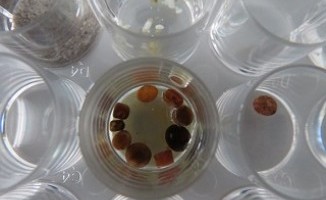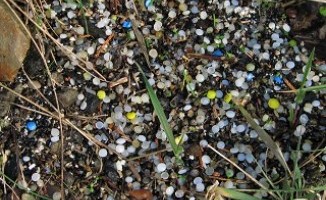Researchers alarmed after finding deadly plastic pellets in the stomachs of dead seabirds
Puffins in the Firth of Forth may have been poisoned by pellets spilled into the sea by the plastics industry.
Researchers dissecting dead seabirds found on the Isle of May found that their stomachs contained – as well as their usual food – small nodules, the size of a lentil.
These have been revealed to be nurdles – the raw material of the plastics industry.
Melted together they form almost all the plastic products we use every day.
However, accidental spills mean billions of these pellets now litter the world’s oceans and seas and the Forth is no exception.
Marine litter is a real threat to all our marine wildlife. It’s important to do all we can to keep our seas clean and litter-free

The dead puffins were dissected by researchers from the Centre for Ecology and Hydrology (CEH) and, while the presence of nurdles does not in itself provide a smoking gun, it is known that the toxic coatings they contain could have catastrophic consequences if ingested by animals.
Researchers confirmed the pellets as nurdles after being contacted by volunteers from the Great Nurdle Hunt campaign – a cross-charity venture backed by the likes of RSPB Scotland, the Marine Conservation Society and the Scottish Seabird Centre.

Mark Newell from CEH said: “We regularly collect puffins found dead on the Island to help us monitor the health of the population. As part of this research we look at what they have been eating.
“At first we didn’t know what the strange pieces of plastics were. When The Great Nurdle Hunt contacted us asking if we had found any small plastic pellets in the seabirds we were studying I realised they were nurdles.”
Tom Brock OBE, chief executive of the Scottish Seabird Centre, said: “The Isle of May is of international importance for puffins and soon tens of thousands of them will return for the start of breeding season. To hear of puffins ingesting nurdles in the Firth of Forth is very alarming news. Not only can nurdles get trapped in their stomach but the toxic chemicals on the surface of the plastic may have terrible repercussions. It is vital that we all do what we can to resolve this issue.”
Iain Rennick, Scottish Natural Heritage’s unit manager for the Forth, said: “The Isle of May attracts around 250,000 seabirds each year making it one of Scotland's largest breeding seabird colonies. It also has one of the UK’s largest breeding populations of puffins. While we don’t fully understand all the impacts they have, nurdles and other marine litter are a real threat to all our marine wildlife. It’s important to do all we can to keep our seas clean and litter-free.”
Cathy Sexton of The Great Nurdle Hunt said: “For almost a year locals from around the Forth and beyond have been scouring the coast hunting for nurdles and reporting their findings. It’s clear from the sightings that there is a serious problem around the Forth. They are turning up on most of our beaches and some parts of the estuary are littered with thousands of them.
“We have contacted the plastic companies around the Forth and using the public sightings shown them the impact nurdles are having on the local environment.
“By adopting simple changes to their operations local plastics companies who manufacture, transport or use nurdles can prevent any risk of spills ending up in the estuary.
“I am pleased to say that as a result we are now in discussion with a number of those companies who are keen to help keep nurdles out of the Forth. However this discovery is a disturbing and serious reminder of the effects nurdles are having on wildlife and the pressing need for industry to act to prevent more seabirds from being affected.”







